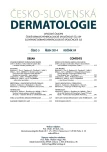-
Medical journals
- Career
Cheyletiellosis – a Less Known Parasitosis
Authors: H. Jedličková 1; V. Vašků 1; R. Just 2
Authors‘ workplace: I. dermatovenerologická klinika FN u sv. Anny a LF MU v Brně přednosta prof. MUDr. Vladimír Vašků, CSc. 1; Soukromá veterinární ambulance, Brno 2
Published in: Čes-slov Derm, 89, 2014, No. 5, p. 233-235
Category: Case interpretation
Overview
The authors describe a case of 19-year old girl with a rash due to Cheyletiella mite infestation of her Maltese Pinscher dog. Cheyletiella dermatitis is an ectoparasitic infection caused by the Cheyletiella mite, attacking primarily domestic animals. Several species are known – Cheyletiella yasguri, the mite attacking dogs, Cheyletiella blakei, parasiting on cats and Cheyletiella parasitovorax attacking rabbits. In humans it causes short limited severely itching disease, on the areas of contact with the infested animal. The disease is not widely known, that is why probably many cases are misdiagnosed. Ectoparasitic diseases besides scabies are caused by a number of mites, infesting animals or inhabiting the same habitat as the man.
Key words:
Cheyletiella – mite – ectoparasitosis
Sources
1. BECK, W. Tierische Milben als Epizoonoseerreger und ihre Bedeutung in der Dermatologie. Der Hautartzt, 1996, 47, 10, s. 744–748.
2. BECK, W., PFISTER, K. [Mites as a cause of zoonoses in human beings]. Wien. Klin. Wochenschr, 2006, 118, (19–20 Suppl 3), s. 27–32.
3. ELSTON, D. M. Cutis, 2004, 74, 1, s. 23–24.
4. http://www.biolib.cz/cz/taxonposition/id78917/
5. HUBERT, J., ERBAN, T., NESVORNÁ, M., STEJSKAL, V. Emerging risk of infestation and contamination of dried fruits by mites in the Czech Republic. Food Addit. Contam. Part A Chem. Anal. Control Expo. Risk Assess, 2011, 28, 9, s. 1129–1135.
6. KIM, S. H., JUN, H. K., SONG, K. H., GRAM, D., KIM, D. H. Prevalence of fur mites in pet rabbits in South Korea. ESVD and ACVD, 19, 2008, s. 189–190.
7. McCLAIN, D., DANA, A., N., GOLDENBERG, G. Mite infestations. Dermatologic Therapy, 22, 2009, s. 327–346.
8. MELTER, O., ARVAND, M., VOTÝPKA, J., HULÍNSKÁ, D. Bartonella quintana Transmission from Mite to Family with High Socioeconomic Status Emerg. Infect. Dis., 2012, 18, 1, s. 163–165.
9. NETUŠIL, J., ŽÁKOVSKÁ, A., HORVÁTH, R., DENDIS, M., JANOUŠKOVCOVÁ, E. Presence of Borrelia burgdorferi sensu lato in mites parasitizing small rodents. Vector Borne Zoonotic Dis., 2005, 5, 3, s. 227–232.
10. SAMSINÁK, K., CHMELA, J., VOBRÁZKOVÁ, E. Pyemotes herfsi (Oudemans, 1936) as causative agent of another mass dermatitis in Europe (Acari, Pyemotidae). Folia Parasitol., 1979, 26, 1, s. 51–54.
11. SCOTT, D., MILLER, W., GRIFFIN, C. Parasitic skin diseases. Small animal dermatology. 5th ed. Philadelphia: WB Sanders, 1995, s. 412–417, .
12. SHELLEY, E. D., SHELLEY, W. B., PULA, J. F., MCDONALD, S. G. The diagnostic challenge of nonburrowing mite bites. Cheyletiella yasguri. JAMA, 1984, 25, 251, s. 2690–2691.
13. SMILEY, R. L. Two new species of the genus Cheyletiella (Acarina: Cheyletidae). Proc. entomol. Soc. Wash, 1965, 67, 2, s. 75–79.
14. TSIANAKAS, P., POLACK, B., PINQUIER, L., LEVY KLOTZ, B., PROST-SQUARCIONI, C. [Cheyletiella dermatitis: an uncommon cause of vesiculobullous eruption]. Ann. Dermatol. Venereol., 2000, 127, 10, s. 826–829.
15. WAGNER, R., STALLMEISTER, N. Cheyletiella dermatitis in humans, dogs and cats. Brit. J. Dermatol., 2000, 143, s. 1110–1112.
16. WEEDON, D. Cheyletiella dermatitis. Weedon’s Skin Pathology. 3rd ed. London (UK): Churchill Livingstone, s. 657, ISBN 978-0-7020-3485-5 2010.
Labels
Dermatology & STDs Paediatric dermatology & STDs
Article was published inCzech-Slovak Dermatology

2014 Issue 5-
All articles in this issue
- Pretibial Myxoedema
- Cheyletiellosis – a Less Known Parasitosis
-
Up-to-date Situation with Gonorrhoea:
Prague STI Center Results – Antimicrobial Susceptibility Monitoring - Structure and Function of Eccrine Sweat Glands and Possibilities of Perspiration Control
- Nimesulid-induced Severe Adverse Reaction of Generalized Bullous Fixed Drug Eruption Type – Case Report
- Czech-Slovak Dermatology
- Journal archive
- Current issue
- Online only
- About the journal
Most read in this issue- Structure and Function of Eccrine Sweat Glands and Possibilities of Perspiration Control
- Pretibial Myxoedema
- Cheyletiellosis – a Less Known Parasitosis
- Nimesulid-induced Severe Adverse Reaction of Generalized Bullous Fixed Drug Eruption Type – Case Report
Login#ADS_BOTTOM_SCRIPTS#Forgotten passwordEnter the email address that you registered with. We will send you instructions on how to set a new password.
- Career

